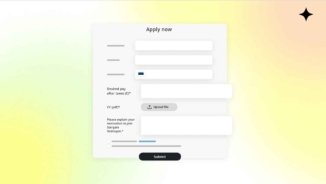Job application forms are a useful tools for recruiters that help get more applicants, build a talent pool, standardise data collection and help filter and screen candidates efficiently.
There is no such thing as a universal job application form that would work for every job opening in and for every target group. However, there are certain effective practices backed by various pieces of research you can follow to ensure your form helps you collect the applications of suitable candidates and manage them with ease.
Job application forms are especially useful for high-volume recruiting and doing the initial screening – filtering the irrelevant candidates from the ones you wish to move further along the recruitment process. This article will give you 5 useful tips for nailing your next job application form.
What is a job application form and why should you use it?
An application form is a form that candidates fill in to apply for a position. The application form effectively allows the recruiter to collect the candidate’s necessary information, including the consent to process their data.
But an application form is more than just a procedural step in recruitment; it’s a strategic tool that shapes the selection process. By standardising candidate information, it levels the playing field, allowing recruiters to compare applicants on equal terms. This form acts as a filter, efficiently sieving out unsuitable candidates based on essential criteria tailored to the specific role, such as specialised skills or relevant experience.
Beyond collecting data, a well-crafted application form reflects the organisation’s professionalism and commitment to equity and compliance. It serves a critical role in legal compliance, particularly in managing personal data, thereby instilling trust in candidates about the organisation’s respect for privacy and regulatory adherence.
In the context of making a good application form, the focus should be on balancing comprehensiveness with clarity. The goal is to gather enough information to make informed decisions while not overwhelming or deterring potential candidates. This balance is key to optimising the recruitment process, ensuring it is both effective and respectful of applicants’ time and effort.
Job application forms are used both on career pages and recruitment landing pages
Application forms embedded within career pages and job ad landing pages are indispensable, especially when you have built a strong and attractive employer brand. These forms not only serve as a bridge connecting potential candidates to employers but also play a crucial role in streamlining the recruitment process. A well-structured application form on these pages ensures that interested candidates can easily submit their details, enhancing the user experience and increasing the likelihood of attracting top talent.
The integration of these application forms with recruitment software is a game-changer for efficient candidate management. The Teamdash forms are the link between your public job ad and your Teamdash project. It can be used with Teamdash landing pages or via iFrame on any other website. When information from applicants flows directly into the recruitment system, it eliminates the cumbersome task of manually sorting through emails. This direct integration facilitates a more organised and systematic approach to handling applicant data. Recruiters can quickly access, sort, and evaluate candidate information, which significantly expedites the screening process and improves the overall efficiency of the recruitment cycle.
Moreover, the seamless transfer of data to recruitment software ensures consistency and accuracy in handling applicant information. It plays a pivotal role in maintaining compliance with data protection regulations like GDPR, as the software typically includes features designed to manage personal data securely. The strategic use of application forms within career pages and job ad landing pages, coupled with their integration into recruitment software, is thus a critical factor in modernising and enhancing the recruitment process.
What makes a good application form? Here are five main tips
1. The number of fields in the form affects the number of candidates you get
The common knowledge is, the more fields you add to the form, the fewer candidates you get. This can also be viewed as a positive – by adding specific fields and requirements to your application form, you avoid random applicants who are applying to every open position, regardless of whether it fits their profile.
If you’re hiring for high-volume positions, though, remember that the shorter the form, the more candidates you get. This way, you can get a wider choice of applicants. However, it does not guarantee better quality of candidates so an effective form includes field(s) which help you sort out irrelevant candidates.
HubSpot analysed over 40,000 landing page forms and discovered that forms with 3 fields had the highest conversion rate (slightly over 25%), followed by forms with 5 fields (above 21%). Additionally, the study found that adding more single-line text fields doesn’t impact the response rates that much, but adding multi-line text fields (free-form text fields) or drop-down boxes tends to decrease conversions more.
Another study by HubSpot found that forms with 7 or fewer fields have a conversion rate of 34%, while those with 10 or more fields have a conversion rate of just 15%.
So it’s a balancing act between the form completions and getting the information you need.
2. Keep your target group in mind when adding fields to the form
Know your target group when choosing between different form fields. For example, people who do not use computers in their day-to-day work (such as various manufacturing and customer service positions) might not have a well-presented CV.
Asking for a CV in the first step of the application process might mean you lose potentially suitable candidates. Instead of requiring a CV, make the form simple and add only the necessary fields: name, phone number, email, and current employer. The rest of the information can be asked later over a phone call.
If you’re asking the candidates to submit their CV, there’s no need to ask for duplicate information in the form.
If you’re recruiting for positions where you can already predict a storm of applications (such as assistants and marketing specialists), then it’s useful to ask them to reply to a specific question on the form.
Or maybe there is a certain requirement the applicant must be qualified for? Perhaps higher education, language skill, working permit or location? Add the option to tick a box to immediately exclude the candidates that do not meet your requirements. Then you won’t spend extra time going through their applications to discover that they don’t fit the position.
3. The application form must be mobile-friendly!
Candidates like to apply using their phones, so your application forms must adapt to phone screens. You should also keep in mind that it is much easier to fill in a shorter form over the phone, and people might not have their CVs saved on it. Consider whether you even need a file upload in your form – maybe a link to the candidate’s LinkedIn profile or asking for their contact information will suffice?
You don’t have to worry about mobile-friendly application forms in Teamdash, as application forms built with Teamdash adapt easily to various devices and screens.
4. Think about the privacy policy and consent
In Teamdash, you can add your company’s privacy policy to the application form, so the entire process complies with GDPR.
Also, think about whether you’d like to ask them for consent to keep their data for future opportunities, being included in your Talent Pool. In that case, you can create a valuable candidate database and make your recruiting much more effective.
Maybe you’d like to add them to your newsletter list or conduct a background check. Whatever consent you need from your candidates, Teamdash’s application form makes it easy to ask.
5. Think about the confirmation message
Think about the confirmation message the candidate sees after applying. Will you let them know immediately about the next steps or direct them to your blog? Maybe you even have extra materials to share about preparing for a better job interview. That is a clever way to keep a candidate’s attention even longer and create a clearer picture of your organisational culture. It also gives them the clarity that their application has been received.
Want to see how Teamdash can help you easily create and embed custom forms to your landing pages and ads? No designer or IT person needed!



